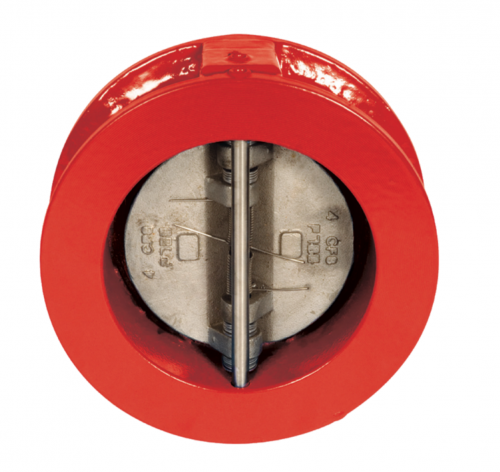After suffering years of water hammer problems and the resulting effect on maintenance, personnel, and equipment, the St. Charles Parish Municipality in Louisiana needed a product that would save them both time and money. Milliken Valve Company of Bethlehem, Pa., provided the answer.
The Double Disc Check Valve Installation
St. Charles Parish Water in Louisiana has a transfer pump station, pumping out of their clear well into their storage tanks. The two pumps would each kick on and off around 300 times a day. The pumps are pumping 2400 gpm at 15 psi with a length of pipe of 220 feet. With the pump cycling on and off so frequently coupled with a critical closure time of 0. 13 seconds, conventional lever and weight cheek valves would last only 6 months.
The first check valves used by St. Charles Parish Water were AWWA Swing Check Valves with outside lever and weight. After months of service, the weight would break off, shafts would break, and everyone would jump when the valve closed due to the water hammer slamming the disc closed. It was very time-consuming for St. Charles Parish Water employees to weld the lever arm and replace the disc.
Several years later, St Charles installed wafer-type double disc check valves. This type of check valve was less expensive and less time-consuming to repair. The double disc check valves were spring-loaded to help the valve close faster but not within the critical closure time, so they also slammed closed.
The valves would last six months in service before the internal springs would break and the seating surface would be damaged. St. Charles Parish Water entertained the use of pump control check valves that would solve the water hammer problem but these had a big price tag.
The Solution
The solution in St. Charles Parish’s case was to install Milliken Flex Check Valves to the discharge flange of the pump. Typically, manufacturers prefer that check valves be installed at least seven pipe diameters downstream of the pump because of turbulence from the impeller. However, due to space limitations, this was not an option with St. Charles Parish Water. The Milliken valve with its nylon reinforcement in the flex area of the disc performed perfectly in this turbulent flow. The effect was immediate. Not only did the ductile iron Flex Check Valve resolve this installation’s water hammer problem, but it did so economically. When the pump was turned off, the disc closed quickly and quietly. Since the disc is encapsulated in Buna-N, the closing of the disc made a thump instead of the boom that conventional swing check valves made.
By reducing the travel of the disc, the Milliken Flex Check Valve closes prior to flow reversal as the fluid velocity approaches zero, thereby greatly decreasing the conditions that create water hammer. This valve has only one moving part, the disc, which is a fully encapsulated steel plate in Buna N. The flexible hinge portion of the disc is warranted for 25 years and has been independently tested and verified to provide one million cycles without damage to either the disc or seat. And the valves are designed with the disc at a 45 degree angle that travels a mere 35 degrees while providing a 100 percent flow area.
Water Hammer at a Glance
The Critical Closure Time is the time the pressure wave travels down the piping system and back (two times the length of pipe) which is divided by the celerity of the wave, which is 3280 feet per second for carbon steel pipe (2 X 220 feet / 3280 = 0. 13 seconds). When the pump stops, this causes inertia of the flow to compress the liquid column and form a pressure wave that travels down the piping system and back to the check valve. If the check valve is still partially open, the pressure wave will slam the cheek valve closed and send another wave downstream.
The design of the Milliken Flex Check Valve, with the short distance of travel for the disc, allows the returning pressure to be dissipated quietly.
No matter what conditions are present at a particular problematic location, keep in mind one thing: The best resolution to a water hammer problem isn’t necessarily the most expensive.
0 copyrighted Scranton Gillette Communications,
Reprinted with permission, WATER &WASTES DIGEST Magazine, August 1 999



